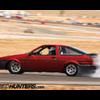Im wondering, will an 80shot of nitrous hurt my motor, cuz im about to go nitrous, and my buddy wants to try to go 80shot. Seeing as this is the only motor I have, and I dont really have money to replace it, I want to know if it would be pushing it.
Welcome to SDR Garage Forums
Register now to gain access to all of our features. Once registered and logged in, you will be able to create topics, post replies to existing threads, give reputation to your fellow members, get your own private messenger, post status updates, manage your profile and so much more. If you already have an account, login here - otherwise create an account for free today!
Register now to gain access to all of our features. Once registered and logged in, you will be able to create topics, post replies to existing threads, give reputation to your fellow members, get your own private messenger, post status updates, manage your profile and so much more. If you already have an account, login here - otherwise create an account for free today!

Nitrous
Started by RicerX, Jun 09 2007 12:24 AM
#1

 Posted 09 June 2007 - 12:24 AM
Posted 09 June 2007 - 12:24 AM

#2

 Posted 09 June 2007 - 01:19 PM
Posted 09 June 2007 - 01:19 PM

I would do a 60 shot to start out with. What size is you're motor? If its 2.0l or below I wouldn't go above a 60, if it's above a 2.0L then a 75 should be fine. I had a 60 and 75 shot on my Legend back in the day for like 4 years, it was a 3.2L tho. I also ran a 60 shot on my B16A in my civic hatch for a long time as well. I ran low 13's with that setup. I kno there are a ton of people out there that say you can go with a higher shot, but 60HP extra on a completly stock motor is quite a bit more. In my opinion 60 is a great number for a stock internal motor. ANything higher and I would want to start building it to take what your trying to accomplish.
#3

 Posted 09 June 2007 - 11:34 PM
Posted 09 June 2007 - 11:34 PM

QUOTE (mestizo @ Jun 9 2007, 03:19 PM)
I would do a 60 shot to start out with. What size is you're motor? If its 2.0l or below I wouldn't go above a 60, if it's above a 2.0L then a 75 should be fine. I had a 60 and 75 shot on my Legend back in the day for like 4 years, it was a 3.2L tho. I also ran a 60 shot on my B16A in my civic hatch for a long time as well. I ran low 13's with that setup. I kno there are a ton of people out there that say you can go with a higher shot, but 60HP extra on a completly stock motor is quite a bit more. In my opinion 60 is a great number for a stock internal motor. ANything higher and I would want to start building it to take what your trying to accomplish.
Ive got a 1.8L. I know turbo is different than nitrous, but its known that the 00 and up celicas can handle up to 12 pounds of boost on stock internals. If im right, thats more than 60 horses cuz at about 10 pounds its somewhere at 210+. I had a friend who I believe ran a 75 shot, but blew his motor doing 100 shot. Im deffinetly not going 100 shot. Aside from that, I dont get much time to race, so that bottle will prob last me 2 months. Thanks for the info though, Ill take it into consideration. I really dont wanna blow my motor.
02 Toyota Celica GT (dead)
91 Honda CRX LS V-tec (will be missed)
H1Racing.com
91 Honda CRX LS V-tec (will be missed)
H1Racing.com
#4

 Posted 10 June 2007 - 02:51 AM
Posted 10 June 2007 - 02:51 AM

A 60 shot is the safest and most reliable. As far as a turbo goes its not making that much more HP all the time, where as NOS will make it instantly and through out the entire power band. So it's 60hp from say like a launch at 2000rpm all the way till you let go of the button/switch. That is one of the reasons it is more dangerous. Trust me a 60 shot on your motor will be plenty! Like I said I ran low 13's in my hatch on a 60 shot with a 1.6L. You could run a 75 but go a step colder on your plugs and gap them a lil closer.
#5

 Posted 10 June 2007 - 05:08 PM
Posted 10 June 2007 - 05:08 PM

QUOTE (mestizo @ Jun 10 2007, 04:51 AM)
A 60 shot is the safest and most reliable. As far as a turbo goes its not making that much more HP all the time, where as NOS will make it instantly and through out the entire power band. So it's 60hp from say like a launch at 2000rpm all the way till you let go of the button/switch. That is one of the reasons it is more dangerous. Trust me a 60 shot on your motor will be plenty! Like I said I ran low 13's in my hatch on a 60 shot with a 1.6L. You could run a 75 but go a step colder on your plugs and gap them a lil closer.
How do you find the heat ranges on the plugs? My buddy was telling me to get colder plugs, but I dont know how to the heat ranges, and aside from that, I have to run iridium plugs, so that means they come pregapped. May present an issue. Man, I shoulda spoke to my one friend who had a nitrous celica.
02 Toyota Celica GT (dead)
91 Honda CRX LS V-tec (will be missed)
H1Racing.com
91 Honda CRX LS V-tec (will be missed)
H1Racing.com
#6

 Posted 15 June 2007 - 07:15 AM
Posted 15 June 2007 - 07:15 AM

QUOTE (RicerX @ Jun 10 2007, 07:08 PM)
How do you find the heat ranges on the plugs? My buddy was telling me to get colder plugs, but I dont know how to the heat ranges, and aside from that, I have to run iridium plugs, so that means they come pregapped. May present an issue. Man, I shoulda spoke to my one friend who had a nitrous celica.
To find the heatrange you need to know how the manufacturer labels the sparkplugs. In your case since it's a toyota you would ONLY want to use NGK (oem) or denso sparkplugs. Do NOT use any U.S. plugs, they are different even if the part numbers crossreference as usable.
On the Celica GT's they came with NGK Iridium Sparkplugs from the factory, part # IFR5T-11. With NGK, to determine what heat range the sparkplug is, you take a look at the 1st number (4th digit). The HIGHER the number, the COLDER the plug. In a liner progression (5,6,7,8, etc).
If you decide to go with Denso Iridium plugs, it shows OEM compatible as being part # IK16. On Denso sparkplugs BOTH numbers indicate the heat range, AND they are not a 'linear' progression in part # like the NGK's, they jump several at a time. The next # up for Denso heatrange's is 20, or one step colder. As with NGK the higher the #, the colder the plug.
Found this cool little quote to help you understand what a 'heatrange' is on Denso's website.
QUOTE
Q. Why are there different heat ranges? Which one should I use?
A. Part of your spark plug’s responsibilities, in addition to firing a spark, is to remove heat from the combustion chamber. This is accomplished by channeling the heat through the insulator material and metal housing. From there, the heat is transferred to the cylinder head where the engine cooling system can go to work. A spark plug’s heat range is its ability to dissipate heat. The “colder” the plug, the more heat it can channel out of the combustion chamber. In a performance application, colder heat ranges may be necessary to handle the extreme temperatures brought on by higher compression ratios, forced induction, and high RPM’s. While “Colder” plugs may seem to be the way to go, please remember that the spark plug must achieve its “self-cleaning” temperature where it can burn off fuel and carbon deposits. Otherwise, the plug could “foul out” where it is prone to misfiring and poor acceleration. A plug that is too “hot” can overheat, also causing power loss, detonation, pre-ignition, and possible engine damage. A good, general rule of thumb is to start with the factory recommended heat range. For every 75 to 100 hp you add to your engine, you may go to the next colder step. DENSO heat ranges move up as they get colder; 16 would be our hottest Iridium Power plug, 34 would be our coldest (ranges; 16,20,22,24,27,31,34)
A. Part of your spark plug’s responsibilities, in addition to firing a spark, is to remove heat from the combustion chamber. This is accomplished by channeling the heat through the insulator material and metal housing. From there, the heat is transferred to the cylinder head where the engine cooling system can go to work. A spark plug’s heat range is its ability to dissipate heat. The “colder” the plug, the more heat it can channel out of the combustion chamber. In a performance application, colder heat ranges may be necessary to handle the extreme temperatures brought on by higher compression ratios, forced induction, and high RPM’s. While “Colder” plugs may seem to be the way to go, please remember that the spark plug must achieve its “self-cleaning” temperature where it can burn off fuel and carbon deposits. Otherwise, the plug could “foul out” where it is prone to misfiring and poor acceleration. A plug that is too “hot” can overheat, also causing power loss, detonation, pre-ignition, and possible engine damage. A good, general rule of thumb is to start with the factory recommended heat range. For every 75 to 100 hp you add to your engine, you may go to the next colder step. DENSO heat ranges move up as they get colder; 16 would be our hottest Iridium Power plug, 34 would be our coldest (ranges; 16,20,22,24,27,31,34)
In any case, for sparkplugs for your car to be one heat range colder you want part #'s:
NGK - IFR6T-11
DENSO - IK20
As a side note, I've gone one heatrange colder sparkplugs on my AE86 engine. The reason I did is my plugs were coming out white in color due to my very very hard driving habits, as I was somewhat worried about getting them so hot I'd cause pre-ignition/detonation under high rpm/hard use. I decided to step up to the next colder plug, since then they've been a nice light tan color. Which is indicative of a good running engine/fuel mix as well as telling me the heatrange (or heat dissapation) of the next step colder sparkplug is just right for my engine.
Note: on spark plug color, heres the basic rule of thumb.
White = too hot combustion chamber or too hot a sparkplug.
Light tan to darkish brown = good clean running engine/comb chamber & correct heatrange plug.
Dry black = too much fuel/running rich.
Wet black = oil in combustion chamber (possible bad valve stem seals, valve guides, piston rings, etc.)
Andrew
#7

 Posted 17 June 2007 - 08:48 PM
Posted 17 June 2007 - 08:48 PM

Thanks so much. Man I wish you had a clone living near me. As far as the plugs go, I thought celicas came with denso plugs from the factory. Well, either way, Now I have the knowledge. Hopefully the plugs wont be big or too small.
02 Toyota Celica GT (dead)
91 Honda CRX LS V-tec (will be missed)
H1Racing.com
91 Honda CRX LS V-tec (will be missed)
H1Racing.com
#8

 Posted 18 June 2007 - 10:10 AM
Posted 18 June 2007 - 10:10 AM

QUOTE (RicerX @ Jun 17 2007, 10:48 PM)
Thanks so much. Man I wish you had a clone living near me. As far as the plugs go, I thought celicas came with denso plugs from the factory. Well, either way, Now I have the knowledge. Hopefully the plugs wont be big or too small.
They should be identical except for the heat range.
Andrew
1 user(s) are reading this topic
0 members, 1 guests, 0 anonymous users
 Sign In
Sign In Create Account
Create Account


 Back to top
Back to top











